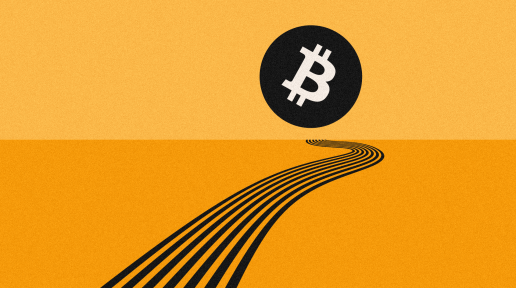Ordinals have been around the Bitcoin block since January 2023, significantly changing the BTC development landscape forever. Users can inscribe data directly onto the Bitcoin blockchain with Ordinals, creating truly digital, completely on-chain generative art. Unlike other blockchains, Ordinals offer immutability and security backed by the world’s largest decentralized ledger. The excitement around Ordinals and Bitcoin L2s over the years has led to a new environment where Bitcoin has increasingly gained on newer blockchains like Ethereum (our CEO Muneeb Ali elaborated on this trend in a recent thread).
NFT ecosystems on other blockchains have taken notice of these unique features — and some opted to migrate their collections to Bitcoin due to them. Typically, the NFT ecosystem on a new chain starts with derivatives of popular projects from other chains. We’ve seen this happen with Punks, DeGods, Apes, and many more projects. However, Ordinals enable a new way of derivatives on the Bitcoin block — one where the entire NFT is migrated from one chain to another.
Ordinals have an in-built Teleburn function that allows users to migrate their NFTs to Bitcoin from other chains. However, the native function can be a bit challenging for users, leading to the development of more user-friendly interfaces like an Ordinal bridge.
Let’s first understand how the Ordinal bridge works.
The Ordinal bridge: BRC-721E standard
The BRC-721E token standard was launched in May by the Bitcoin Milady NFT collection in collaboration with a popular marketplace, Ordinals.market, and a BTC wallet, Xverse. This token standard and its associated Milady bridge enable users to migrate their Ethereum NFTs to Bitcoin using the teleburning feature.
With the bridge, users can directly search for the collection name they wish to migrate and connect their Bitcoin wallet. Once connected, they can choose the NFT to migrate, grant the necessary approvals, and wait for the bridge to complete the process.
In the backend, the bridge sends the ETH NFT to an unrecoverable “burn” address and then follows it by inscribing the BRC-721E data to the Bitcoin network. After the inscription, the migrated NFT appears on Ordinal marketplaces and its accompanying metadata.
Importantly, due to size constraints, BRC-721E token standard inscribes a low-resolution version of the original Ethereum NFT to the Bitcoin blockchain. While this might change in the future, currently, the migrated NFT incorporates a link to the original ETH token in the image data.
Now, let’s look at projects that have used the Teleburn feature on the Bitcoin blockchain.
BAYC ape #1626
The BAYC ape #1626 marks a turning point in Ordinal history since it essentially prompted the development of the Teleburn feature. Jason Williams, the ape's owner, publicly announced that he wanted to migrate his ape to the BTC blockchain. In response to this request, Casey Rodarmor, the developer of the Ordinal protocol, and Rob Hamilton, introduced this unique feature for the Ethereum blockchain.
After an initial test by migrating rodarmor.eth to the Bitcoin blockchain, Casey migrated the BAYC ape #1626, making it the second Ethereum NFT on Bitcoin. The BAYC community isn’t too happy about this transition and considers the ape unrecoverable since it was voluntarily sent to a burn address.
Bitcoin Milady
As the name suggests, the first to use the Milady bridge was the NFT collection that developed it —- Bitcoin Miladys. Bitcoin Milady is a generative PFP collection of anime chibis, a Bitcoin version of the famous Milady Maker collection on Ethereum. Milady Maker was propelled into popularity by a public endorsement by Elon Musk.
With the rise of Ordinals, the project opted to give their community a choice to choose the blockchain they want their NFTs on. The project built both a bridge and a bridging explorer to enable this functionality — and thus, the first BRC721E token bridged to Bitcoin became a Bitcoin Milady.
OnChainMonkey
In a recent high-profile migration, OnChainMonkey announced the transition of its OCM Genesis control to the Bitcoin network. OCM’s core motive was to capitalize on the opportunities the Ordinals offer and create new and upgraded digital art.
The catch? The DAO spent over 1 million dollars to inscribe over 10,000 collection images, a testament to their commitment to the Ordinals protocol. Interestingly, the community decision for this shift was almost unanimous — over 99% supported the proposal.
OCM’s migration was historic in many ways. First, the collection inscribed all 10k NFTs in a single inscription, effectively utilizing the. Secondly, OCM currently exists on Block 9, with the oldest sats in circulation, mined originally by Satoshi himself. This block holds a lot of historical significance to the Bitcoin blockchain, so the community chose to inscribe their collection on it.
The OCM team has truly committed to the Bitcoin blockchain. Their new collection, OCM Dimensions, experiments with cutting-edge Ordinal features such as recursion, on-chain compression, and Parent-child inscription.
The Future of Building on Ordinals
As you can see, the key motivation behind migrating NFTs from Ethereum to Bitcoin is largely driven by the security, decentralization, and immutability the Bitcoin blockchain offers. NFT communities are also primarily driven by rarity — and with a scarce asset like Bitcoin, the rarity aspect blends beautifully. These reasons are precisely why Ordinals have become popular, and people are transferring their million-dollar worth of assets to the Bitcoin chain.
Further, innovations like recursion and parent-child inscription allow multiple inscriptions to be connected. This opens up a whole range of use cases — from games to 3D files and so much more. The best part? Ordinals are still in their early stages, so as with any emerging technology, there are countless possibilities to explore.

